China's Great Wall

The Great Wall is China's best known historical monument. Stretching 1,674 miles [2,694 kms] it has formed China's northern boundary for thousands of years. Impassable mountains form the border to the west and south-west while the sea forms the border to the east. So it is the northern boundary that has always posed the main threat to China. In ancient days, the illiterate, nomadic people of the northern steppes managed herds of grazing animals over the open plains. Occasionally some of these groups would take advantage of their superior horsemanship by raiding over the border into Chinese towns for plunder, especially silk and lacquer-work. Sometimes these raids were large enough to threaten the whole Chinese Empire. In 166BCE 140,000 horsemen came within 100 miles [161 kms] of the capital Chang'an.

Fortress and Great Wall
In Chinese the Great Wall is called 长城 Chang cheng long fortress or 万里长城 Wàn lǐ cháng chéng Ten thousand li long fortress although it actually measures 12,000 li (Li is a Chinese unit of distance of 0.5km). The term ‘fortress’ does seem strange for a wall but the Great Wall was always more than just a wall. It had watchtowers in clear view of each other, continually manned and so there was a continuous requirement for food and other supplies for the thousands of people defending it. It was more like a community strung out along a road than a bare wall. When defenders spotted an enemy a beacon fire was lit which soon propagated to the next in the chain - by smoke (from burning wolf dung) during the day and by fire at night, similar to what can be seen in the ‘Muster of Rohan’ in the Lord of The Rings ➚ film. The beacons alerted defenders to send out help from the nearest forts.
Like other walls around the world, it is just as much about keeping people in, as keeping 'barbarians' out. Without a well maintained border people would be free to evade justice and taxes by just crossing the border whenever they wished. It also performs a key symbolic role of marking the border so people definitely knew if they were inside or outside China.
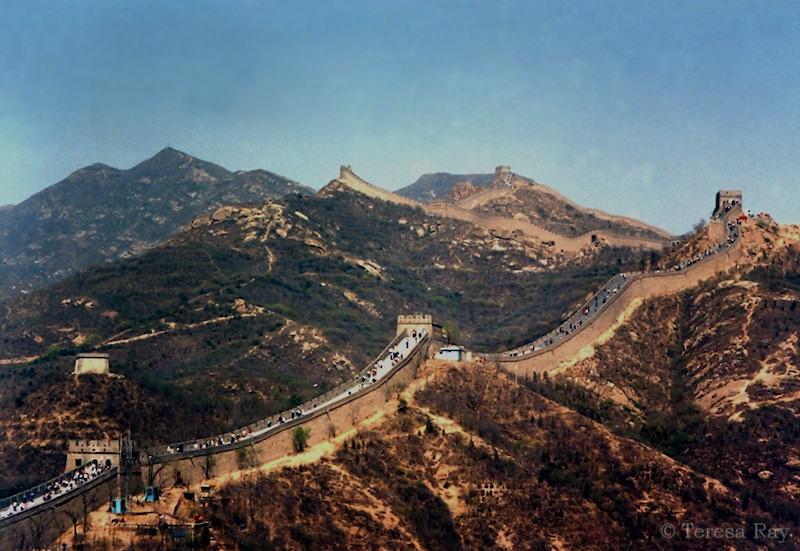
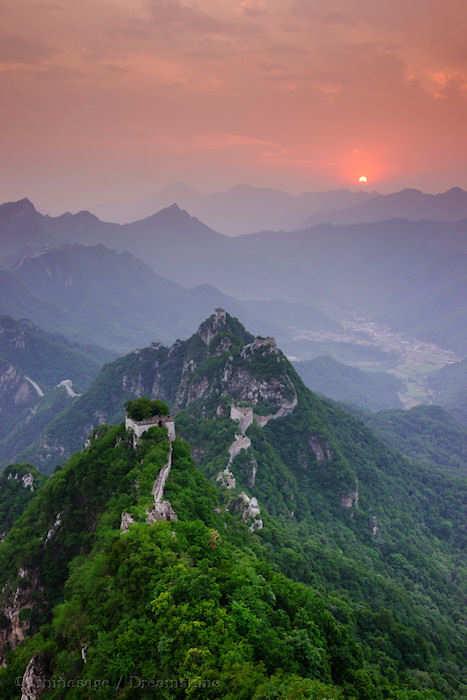
The wall was not all built at one time, much of what people see at Badaling near Beijing is a modern 1950-60s restoration of a Ming dynasty rebuild of an original wall. For many hundred of miles the wall has not been well maintained and is in a state of dilapidation. There are also 'gaps' in the wall, it was never a continuous feature. Far away in the Gobi Desert where stone and wood were not to hand, layers of pounded soil and reeds made an adequate alternative as rain is so rare. So only the easternmost 500 miles [805 kms] from Ningxia looks like the modern image of the Great Wall. There are a few viewing locations open to vast numbers of tourists along the route including: Badaling ➚ 八达岭; Mutianyu ➚ 慕田峪; Huanghua Cheng ➚; Simatai ➚; and Jinshanling ➚ 金山岭.
History
The chief architect of the Great Wall was Qin Shihuangdi - the First Qin Emperor of China who conquered the kingdoms making up China. One of his many initiatives for nation-building was patching up and linking the various walls that had been built over the preceding centuries. Previously, in the Warring States period, many of the kingdoms had built walls to defend themselves from each other rather than the barbarians. He ordered General Meng Tian ➚ to use up to 300,000 slaves to build new and strengthen existing walls. About 500 million tons of material form the wall which makes it, by many measures, the greatest man-made structure ever made in the world. For the Qin dynasty and those that followed, the wall marked the division between the civilized world and the barbarians outside. The ‘Great Wall’ as it is understood today (the brown line on the map) stretches from 山海关 Shan hai guan on the Yellow Sea (near Qin huang dao, Hebei) all the way to the 嘉峪关 Jia yu guan Jade Gate, Gansu in the depths of the Gobi desert. A plaque at Shanhaiguan proclaims it as Tian xia di yi guan 天下第一关 the First pass under Heaven, identifying it as the edge of the civilized world. The tower at the western end at Jiayuguan, Gansu was built in 1372 on the orders of the first Ming Emperor Zhu Yuanzhang, here the walls are 38 feet [12 meters] high and (800 yards [732 meters] long. The story goes that the fort's construction was so carefully planned that only one brick was left over when completed.
Mèng jiāng nǚ孟姜女
Many legends are told of the making of the Great Wall evoke the hardship of the hundreds of thousands who were forced into service to build it. The emperor used conscripted labor and many families lost their men to the endeavor. Of particular concern was the burial of the many who died building it, a very strong cultural tradition dictated that the body should be returned to the ancestral burial ground, but most were just interred under the wall itself. Meng Jiangnu's husband, Fan Xiliang, was one such conscript. Meng Jiangnu ➚ went to seek out her husband and after much searching was told he was buried beneath the wall. After three nights of Meng Jiangnu's sad and lonely vigil, the wall split open revealing the bodies of the dead including her husband clasping the other half a jade hairpin she carried with her. Heartbroken she threw herself into the sea. A temple at Shanhaiguan commemorates the legend.
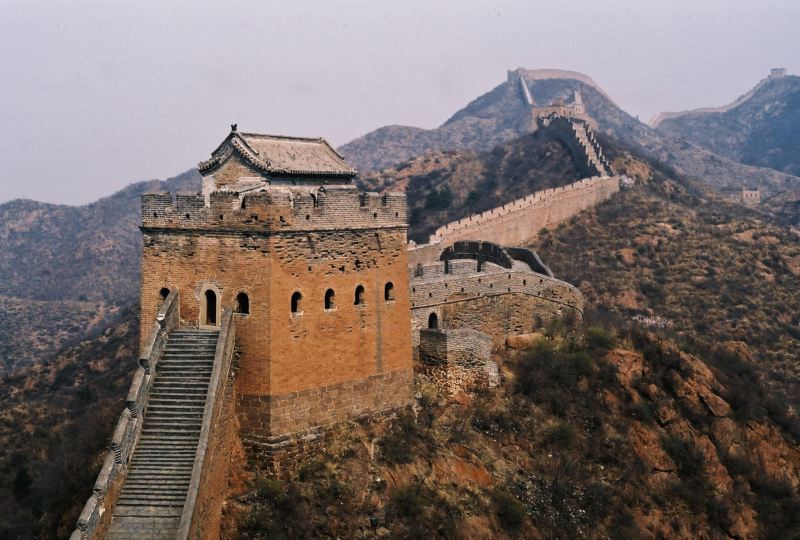
Built to take five horsemen riding abreast with regular watch towers and forts, the Great Wall was designed to impose itself on the landscape. This led to some to hypothesize that it could be seen from the Moon long before space travel. This did not turn out to be true, the Great Wall is only a few yards wide, and features that small can not be seen from such a distance. The suggestion was probably triggered by the apparent discovery of canals on Mars ➚.
After the Qin dynasty the succeeding Han extended the wall to the west to defend the new territories they had conquered (the Gansu corridor). Over the next few hundred years the Great Wall served mainly as a border marker and little was done to keep it in good repair. It was only on the reunification of China under the Sui dynasty that the Wall was repaired and strengthened using as many as a million men as laborers. It served its purpose well for many centuries, but when the Mongols invaded it kept them back for only a few years (1211-1215). When the Mongol dynasty came to power the wall lost any strategic value as Mongolia and China were united and it fell into disrepair again.
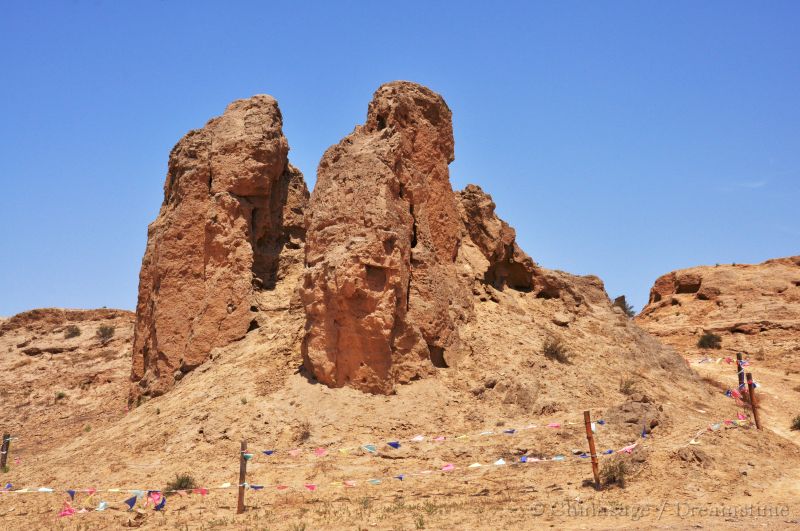
Ming re-build of the Great Wall
During the following Ming Dynasty paranoia about possible attacks from the north led to a military expedition northward by Emperor Zhengtong ➚ in 1449. It led to a humiliating defeat brought on by incessant rain and poor leadership. An estimated 500,000 troops took part, and it ended up with the capture of the Emperor himself and the massacre of the army. This debacle led many to favor a strengthening of the Great Wall to block any further trouble and forget any ideas of conquest north into Mongolia. The new line of the wall did, in places, follow a different line to the original Qin wall. The crippling expense of the wall was a subject of great debate, construction started in 1455 and continued sporadically until the fall of the dynasty in 1644. Rather than the low, earth built walls in the western section the Ming walls were chiefly of stone. Each section was allocated to a district within China who had to supply the conscripted labor - they would formed a mini-community while the wall was built. At strategic points it was not just a single line of wall but made of two or more parallel walls. The average height was 24 feet [7 meters] and 21 feet [6 meters] thick at the base. The core was filled with earth and rubble while the top was lined with three of four layers of brick. A carriage could ride along the top of the wall. A series of cannons were mounted along the wall to defend it.
Qi Jiguang 戚继光 qī jì guāng [1528-88]
The peak of Ming dynasty wall building came under the military hero Qi Jiguang. In 1550 Altan Khan broke through the wall and invaded the outskirts of Beijing. The Emperor had no choice but to buy him off with ‘tribute’. However raids by Mongols still continued, particularly under Tümen Zasagt Khan ➚. Meanwhile Qi Jiguang rose the military ranks by building a new model army to defeat Japanese pirates on the south coast. He instilled discipline, bravery and loyalty among his troops. He published an influential training manual (练兵实纪 Liàn bīng shí jì) ‘Record of Military Training’.
When Qi Jiquang moved back to Beijing he was given the task of defending against attack from the north. His audacious and very expensive plan was to populate the wall with watchtowers so that any attempt at a raid could be quickly countered. Previously the wall had been just a wall, it was Ji's strategy to turn it into an armed fortress. He had the crucial support of Zhang Juzheng ➚ who as Chief Grand Secretary could provide the enormous funds needed. Under Ji's command over 1,000 watchtowers were built in stone with stone walls in between. Qi then successfully led an offensive into Mongol territory and captured their leader Dong Huli. In exchange for Dong's return the Mongols vowed to stop their raids. So Qi's defenses proved effective but soon the new Emperor was so concerned by the vast expense of the continued building and maintenance that Ji was 'demoted' in 1583. He returned home in poverty, was left by his wife and lived in poor health until his death in 1588.
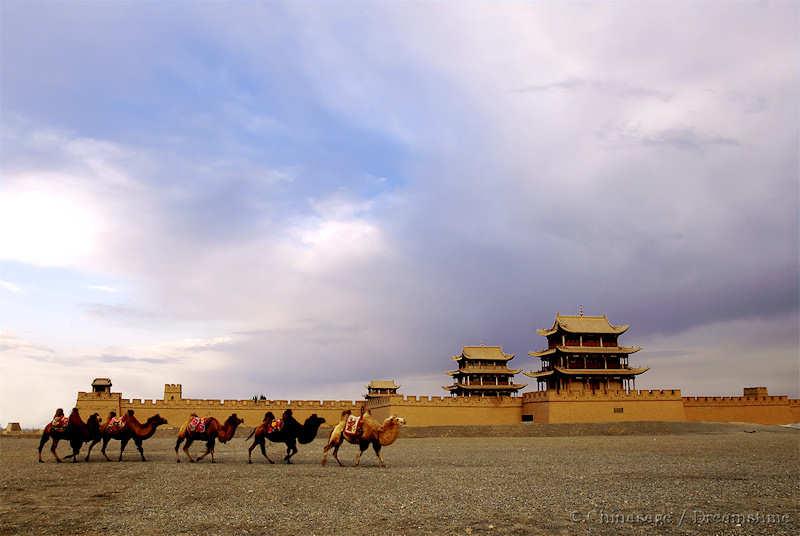
Manchu invasion
All this effort in building an immense wall was to eventually prove pointless. The fall of the Ming dynasty to the Manchus who lived beyond the wall was fueled by internal strife as much by foreign assault from beyond the Great Wall. It was the rebellion led by Li Zicheng ➚ that sparked the demise of the dynasty. Li was born at Yan'an, Shaanxi (later to become Mao's wartime base) and rebelled against excessive taxes and oppression. His revolt soon gathered mass support at a time of hardship due to famine, he stormed the ancient capitals of Luoyang and Kaifeng. Li then declared himself leader of the new ‘Shun dynasty 顺朝’ at Xi'an in 1644. Meanwhile the Ming troops were deployed away in the north-west to hold off a possible Manchu invasion and were unable to prevent Li's revolt reaching Beijing. When Beijing fell, the Ming General Wu Sangui ➚ 吴三桂 fatefully formed an alliance with the Manchus to defeat Li and restore the Ming dynasty. With the Ming Emperor now dead, the Manchu troops took advantage and after defeating Li promptly installed themselves as the new dynasty. The Great Wall with all its impressive defenses, still in the process of construction and designed for just such an eventuality played no part in the overthrow, the Manchu army had been let through the gates with open arms.
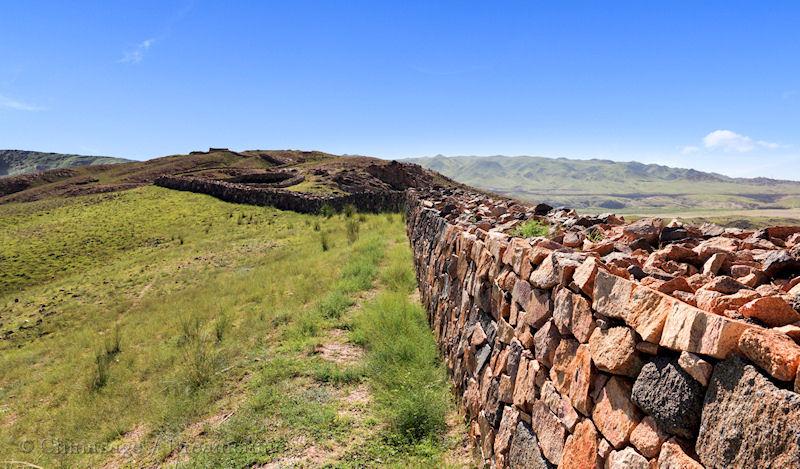
The Great Wall today
With the extended northern area under Qing control, including Mongolia the Great Wall once again lost strategic value and was not maintained. It was only 400 years later, with the foundation of the People's Republic that the wall came back into importance. Partly due to the great impression made by the Wall on foreign dignitaries (such as Lord Macartney 1793) it became a symbol of China's longevity, strength and achievement. Sections near to Beijing were then restored to ‘pristine’ condition while other sections have been left to rot and these form the ‘rough wall’ that can still be seen today.
One of the western visitors who was impressed by the wall was W. Somerset Maugham, one of the foremost English writers of the 1930s. He wrote:
“There in the mist, enormous, majestic, silent, and terrible, stood the Great Wall of China. Solitarily, with the indifference of nature herself, it crept up the mountain side and slipped down to the depth of the valley. Menacingly, the grim watch towers, stark and foursquare, at due intervals stood at their posts. Ruthlessly, for it was built at the cost of a million lives and each one of those great grey stones has been stained with the bloody tears of the captive and the outcast, it forged its dark way through a sea of rugged mountains. Fearlessly, it went on its endless journey, league upon league to the furthermost regions of Asia, in utter solitude, mysterious like the great empire it guarded. There in the mist, enormous, majestic, silent, and terrible, stood the Great Wall of China. ” On a Chinese Screen, W. Somerset Maugham, Chapter 29.
There are many conservation works in progress to restore parts of the wall, but as it takes one man a year to rebuild 875 yards [800 meters] - it's going to take a long time. Back in the heat of the Cultural Revolution during the attack on the ‘four olds’, the wall itself suffered, a section of the Wall at Gubeikou was dismantled to build PLA barracks, but this policy was swiftly reversed and this section rebuilt. Mao took the Great Wall as living proof that the Chinese could undertake massive construction projects and succeed. It was Mao who said ‘He who does not visit the Great Wall is not a real man; and he who does not love the Great Wall is not a hero’.